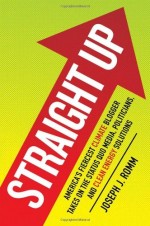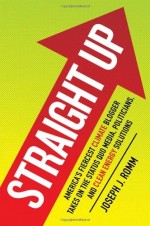 Joe Romm is pissed off — and I’m delighted.
Joe Romm is pissed off — and I’m delighted.
His latest book, Straight Up, takes on the oil and coal companies, the skeptics, and the press. His unfailing sense of priorities shines through his startlingly thoughtful and brutally blunt writing.
I have one problem with his book — but more about that later.
As an assistant secretary of energy during the Clinton administration, Romm developed expertise in the area of renewable energy technologies. As a climate blogger, his even greater asset is his intelligence.
Straight Up is a compilation of posts from Romm’s popular blog Climate Progress. And while one wishes Romm would have stitched the blog posts together into a more coherent narrative — and omitted a few that addressed transitory, fleeting events — his book is absolutely on point in its insistence that climate change long ago ceased to be a scientific issue and, instead, is most clearly a political one.
Take the climate bills pending in Congress. Even though all the proposals on the legislative table are pitifully inadequate to the catastrophic threat of accelerating climate change, Romm’s book makes the subtext crystal clear.
The conflict in Congress is not really about the science. “The conflict is actually a political one between those who believe in government-led solutions and those who don’t.” As Romm points out, a central reason that most political conservatives and libertarians deny the reality of human-induced climate change “is that they simply cannot stand the solution. So they attack both the solution and the science.” I don’t recall reading that simple truth in The Washington Post, The New York Times, or any other major news outlet — virtually all of which treat the climate debate as though it actually had some legitimacy.
Similarly, I share Romm’s critical take on the news media for their complicity in creating our gathering nightmare.
Having spent 30 years as an editor and reporter at some of the country’s major newspapers, I don’t think the worst offenders in the hierarchy of climate villainy are the executives of Big Coal and Big Oil. They’re simply doing what they’re paid to do: bring us cheap and abundant energy — and defend their industries against the imperatives of the science and the onslaught of environmentalists.
The larger villain, from my point of view, is the mainstream press that has consistently failed to prepare the public for the coming turbulence. The major U.S. news outlets have failed to prominently highlight major climate science findings. They have failed to mention the role of warming in the increasing frequency and intensity of extreme weather events. And they have failed, in the name of “journalistic balance,” to distinguish between legitimate, peer-reviewed scientific research and the deliberate obfuscation by a cadre of climate skeptics, many of whom have been funded by coal and oil companies.
As a result, the public has no idea that we are already at a point of no return in terms of staving off climate chaos.
Citing the dire forecasts from the most recent IPCC report — which significantly underestimate the urgency of the situation — Romm blasts the media for treating climate skeptics “as if they had a scientifically or morally defensible position.”
Moreover, because the media largely continues to report the climate controversy as though it had a middle ground, “they push us closer to the certain catastrophe of inaction,” as Romm writes.
His chilling conclusion: “It appears to me that today’s media simply can’t cover humanity’s self-destruction.”
In a similar vein, Romm skewers the media for failing to connect the intensification of extreme weather events around the world to our burning of coal and oil.
That connection was established as early as 1995, when Tom Karl, David Easterling, and other scientists at NOAA’s National Climatic Data Center concluded that as earth’s temperature increases, we will see more temperature extremes, more intense downpours, and more protracted droughts, among other consequences. Those findings were elaborated in a 1997 Scientific American articled titled “The Coming Climate.”
Nevertheless, Romm points out that the coverage by the majority of the U.S. news outlets of last year’s hellish wildfires in Australia contained no mention of warming-driven heat waves and droughts. Romm cited a Reuters headline which read, “Australia Fires a Climate Wake-up Call: Experts.” By contrast, ABC News anchor Charles Gibson called them “part natural disaster” and partly the product of arsonists. ABC’s World News Tonight said not one word about the role of human-induced atmospheric warming in the long heat wave and drought that created such hospitable conditions for the wildfires.
On the economic front, Romm is equally ruthless in his criticism. For one thing, the press and many economists have consistently overestimated the costs of mitigation, starting with the simplest of all remedies: efficiency. In Romm’s view, the U.S. is the “Saudi Arabia of energy waste.”
While the press parrots the prevailing economic line that mitigation will be crushingly expensive. Romm notes that during his five-year stint at DOE, “I never saw a building or factory that couldn’t cut electricity consumption or greenhouse-gas emissions 25 to 50 percent with rapid payback.”
More to the point, Straight Up quotes Eric Pooley, a former editor at Fortune and Time magazine: “The press misrepresented the economic debate over cap-and-trade. It failed to recognize … that cap and trade would have a marginal effect on economic growth and gave doomsday forecasts … The press allowed opponents of climate action to replicate the false debate over climate science in the realm of climate economics.” As Tufts University economist Frank Ackerman said recently, “It’s not the costs of mitigating climate change that worry me, it’s the costs of inaction.”
I also share Romm’s impatience with policy analysts who continually call for more R&D to solve the climate crisis. Right now we have all the technology we need to begin reducing emissions quickly and cheaply. Romm happens to favor both efficiency and concentrated solar thermal power. But, his technological preferences aside, he’s right on point when he describes the call for more R&D as a stalling tactic to avoid coming to grips with the threat. As Romm writes, “deployment completely trumps research.”
Romm does overlook one critical point. While renewable technologies may be relatively expensive at this point, that is not a function of economics. It is, first and foremost, a function of political will. Were the world’s political leaders to mobilize around the need to rewire the world with clean energy, the costs of solar panels, solar towers, wind turbines, appropriate hydroelectric facilities, and other technologies would drop dramatically as they were ramped up to mass production and economies of scale. (For one set of strategies to accomplish this, see here.) Recall, for instance, that prohibitively expensive early television sets and computers became quickly affordable when their production and marketing were scaled up.
But for all the uncompromising wisdom in Straight Up, I still have a problem.
Toward the end of his book, Romm wanders into the question of why climate advocates are so bad at “messaging.” It may be a valid question. Foundations have poured thousands of dollars into exploring how best to communicate the realities of climate change. George Lakoff, for one, has devoted a substantial amount of time to wrestling with this question.
But I’m afraid the issue of “messaging” is a swerve — a diversion from the real question facing all of us at this moment of history.
We have already passed the point of no return. We are already beginning to see crop failures, water shortages, increasing extinctions, migrations of environmental refugees, and all manner of potential breakdowns in our social lives.
Where Straight Up falls short is in its failure to deal with this reality head on. It is not a pretty scenario. When governments are confronted by collapse, they too often resort to totalitarian methods to keep order in the face of chaos. Given the increasingly precarious state of our climate, it is not hard to foresee governments resorting to permanent states of martial law. And it is not hard to imagine a short-term state of emergency morphing into a long-term state of siege.
This is not at all to minimize the value of Romm’s book. To the contrary, if you think the most pressing task today is to limit the coming damage through a transition to non-carbon technologies, I can’t think of a better place to start than by reading Straight Up.
But that transition can only be a start.
Unfortunately, we have already passed a point of no return in terms of staving off massive disruptions. It is time to begin talking about how to preserve a coherent human community without a retreat into mass survivalism. It is time to start planning how we can endure in a world that will be far less stable and far more threatening than the one we grew up in.
Perhaps this is an unfair knock on Romm. Perhaps it is not environmentalists — even extraordinarily intelligent ones like Romm — to whom we should be looking for these kinds of answers.
The overriding threat to our collective future used to be an environmental one. Today it has grown into a global existential one.
Environmentalists have done us a great service by identifying the problem. But the real challenge, I think, goes far beyond the reach and expertise of Joe Romm or, for that matter, any other environmentalist.
The question of how to reorganize society in the face of impending collapse comes down to a choice between a radically more coordinated, cooperative global community and a scatter of fortressed, tribalized, and highly defended enclaves.
That is the real question facing us today. It is a question that requires courage. It is a question that requires trust. Finally, it is a question that requires the very best thinking of people from every continent, every discipline, and every single walk of life.



